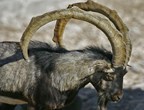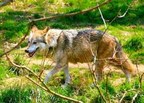Greece is famous for its sandy beaches and historical sites. However, apart from amazing sites, it also has a diversified wildlife. The rugged mountains of Greece cater large variety of animals. You can even find some of exclusive endangered species in the forests of Greek land. Greece due to its mountainous landscape has provided a shelter to all kinds of wildlife and the segregation has allowed plants to grow separately. Below it’s a list with the most characteristic wild species which appear in the Greek nature.
The brown bear (ursus arctos)
The brown bear is the largest land mammal in the entire Europe with length 1.70-2 meters and weight 60-250 kilograms depending on sex and the season of the year. It usually lives approximately 25 years. The female bear borns every 2 years one to three little bears during the hibernation period. The Greek population today is about 300 bears and they live mainly on the Pindus Mountains and in Rodopi. The bear needs quietness so is moving during the night to avoid humans. Although if you meet one you have to remember that it must not feel threatened so you should stand still or move slowly away from its way!
The wolf (canis lupus)
The wolf in Greece has brown color and they are characterized as Mediterranean. Its body length is around 1.50 meters and its weight 20-60 kilogrammes depending on different factors. They usually live 8-16 years and are reproduced every year from February until April and finally the female gives birth to 3-7 little wolves. Their common dietary includes deer, boars, rodents and rarely vegetables. You can meet them (not recommended!) almost in every highland big forest in Greece.
The fox (vulpes vulpes)
The most known kind of fox in Greece is the red fox. Its hair is ruddy with white coloured legs and belly. Its length is around 60-90 centimetres and its tail is quite tufted, its weight is approximately 7-10 kilogrammes. The fox lives a lonely life except the reproducing period of January. One fox can bring forth 4-5 baby foxes. It lives almost everywhere; from plains to forests and to areas with intense human presence.
The hedgehog
This pretty little animal loves to live in Greece. You can meet it almost everywhere especially there where are sparse forests and undergrowth. The female is more fat and with longer snout than the male. The wild hedgehogs are basically nocturnal animals and during the daylight are sleeping in a hole on the ground or under rocks. During the winter they can fall in hibernation or not depending on the temperatures, the amount of the available food and their kind. This process is like this; the autumn they create a nest with moss and leaves under a tree and fall into hibernation which lasts until March or April. The body temperature in this period drops to 5.5 degrees C. the hedgehog can eat everything like watermelons, frogs, eggs, snakes and many others.
The unique wild goat – the Cretan Kri Kri
The proud Cretan wild goat (Capra aegagrus creticus), also known as agrimi, wild goat or Cretan ibex is an endemic subspecies of wild goat specifically is the only species of ibex in Europe. According to its genetic characteristics, the wild goat was introduced in Crete from Asia and then came to contact with the ordinary goats on the island while retaining many of the genetic characteristic of its Asian cousins. By the early 20th century, ibexes were spread in the three major mountains of Crete (White Mountains, Ida and Dikte) but their natural population is currently limited to just 700 all living in the National Park of Samaria, in the White Mountains, in an area of 150,000 acres. The goats almost disappeared from the entire Crete during the Second World War, as the guerrillas had no other source of food. In 1960, there were only 200 goats in the White Mountains and therefore Samaria was declared as National Park in 1962. Even today wild goats in the White Mountains are threatened by illegal hunting, limited grazing areas and diseases. However, hybridization is a principal threat for conserving the subspecies alive, as their gene pool is mixed with ordinary goats. The Cretan ibex has a dark brown coat which during October and November becomes lighter. There is a black strip on its back, from head to tail and the males have a long beard. Moreover, it has two horns swept back from the head that reach the 1 meter in males. Its body length reaches 1.30-1.40m and its weight is around 40kg. When the ibexes get 10 years old, their coat colour gets lighter. Usually they live for 11-12 years. The goat eats shoots and leaves of shrubs and low trees, grasses and broadleaf herbs. It prefers rocky areas with steep slopes as it can jump over 8 meters. In the summer, it moves to higher altitudes. Archaeological excavations have found several wall paintings of the kri-kri. Some academics believe that this animal was worshiped on the island during antiquity. Today it is an emblem for the island of Crete.
Other wild species
You can find beautiful and wild expressions of the live nature in the entire Greece. Some of them are the ferret, the mink, the badger and the lovely squirrels. Also are hosted different species of the rodents’ family as the beavers, the chinchillas and the wild rabbits and bunnies.
Aquatic wild life in Greece
The Mediterranean seal monachus-monachus is one of the most endangered species on the planet. In the Mediterranean live around 400 monks while the 300 of them live in the Greek territory especially in Northern Sporades. This seal is a health indicator of the marine environment and part of the rich biodiversity of Greece. It is considered by the International Union for Conservation of Nature (IUCN) as a species directly threatened with extinction and is therefore protected by international and national level laws. Also, in the Greek seas live some other irresistibly cute and smart animals. The dolphins. There are 4 kinds of them in Greece; the bottlenose dolphin, the common dolphin, the striped dolphin and the Risso’s dolphin. Also, there is the National Park of Zakynthos which is the first park in the Mediterranean which was set up for the protection of the sea turtles. It is located in the island of Zakynthos in Laganas Bay. The shallow clear water of Laganas Bay hosts a fascinating beauty of sea life and some rare sea animals. The loggerhead turtle caretta-caretta is one of them and the beach works as a ground for nesting for this endangered species.
Bird Watching
Greece’s Diversified landscape, suitable climate, fresh water lakes and natural wetlands are intriguing for birds and provide an ideal upbringing for different species of flora and fauna. In Greece around eight hundred species of native flora are found that are unimaginable to find in any other part of the world. The tourists enjoy bird watching activities at different parts of Greece. There are nine ‘’Ramsar’’ sites and around one hundred and ninety six Important Bird Areas where you can find number of endangered species of birds come for reproducing. The exclusive and endangered species you can observe on these bird sights include Lesser Kestrel, Cinereous Bunting, Dalmatian Pelican, Audouin’s Gull, Vulture and Ferruginous Duck. In Crete, you can find some magnificent locations for bird watching activity. Some very rare species of birds visit these sites in winter, such as Blue throats, Starlings and Black Redstarts. Also the place hosts some migrants and breeding birds like bitterns, spotted flycatchers and ferruginous ducks can be easily watched in the breeding season. In Lesvos Island there is the only spot which hosts Cinereous Bunting and the Krüper’s Nuthatch. Lesvos is a heaven for bird lovers as thousands of species of birds pass over or stops at the island and some are rarely getting found in any other place of the world. In the National Park of Parnassus has found home a wide variety of animals and different species of birds who visit the park in different migrating seasons of the year, such as woodpeckers, linnets, large raptors thrushes, robins and golden eagles. Finally, the National Park of the Olympus Mountain is famous worldwide due to its natural beauty and the remarkable ecological features. It works as a home for a large number of animals and birds. Olympus name is enlisted in ‘The Most Important Bird areas of the European Community’ and this National Park was declared as a Biosphere Reserve by the UNESCO in 1981.
In conclusion
Every year thousands of wildlife lovers come to explore the beauty of the natural habitats and watch some rare species of animals and birds. Although Greece is a small country, it has more number of amphibians and reptiles species as compared to Spain or France. For example it hosts around seventy different species of amphibians and reptiles. All these wild but also pretty animals deserve our admiration, love and protection. So is good to remember to keep the environment clean as it is their home.




